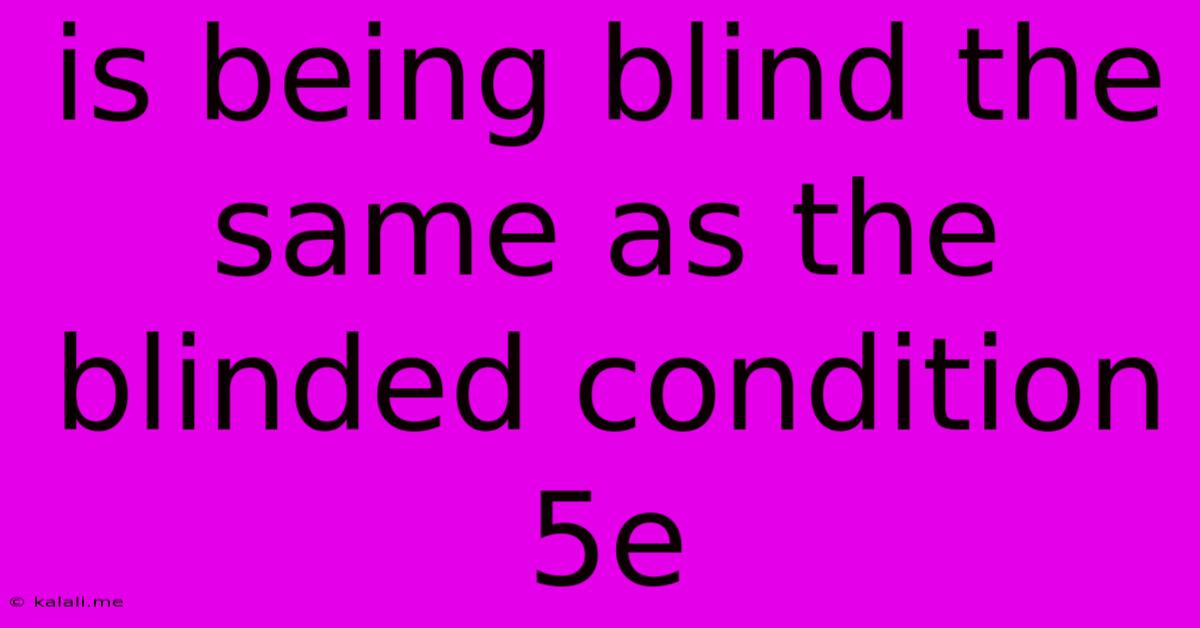Is Being Blind The Same As The Blinded Condition 5e
Kalali
Jun 09, 2025 · 3 min read

Table of Contents
Is Being Blind the Same as the Blinded Condition in D&D 5e? A Comprehensive Look
The question of whether being blind and the blinded condition in Dungeons & Dragons 5e are identical often arises. While seemingly straightforward, the answer requires a nuanced understanding of both concepts. This article will delve into the specifics of each, highlighting their similarities and crucial differences, ultimately clarifying how they function within the game.
Meta Description: Understand the key distinctions between true blindness and the blinded condition in D&D 5e. This article clarifies the gameplay implications and rules surrounding each, helping players and DMs make informed decisions.
Understanding True Blindness
True blindness, in the context of a fantasy setting like D&D, refers to a permanent or long-term inability to see. This isn't simply a temporary impairment; it's a fundamental characteristic of a character. A character born blind, or one who has suffered irreparable damage to their eyes, would be considered truly blind. This generally translates to a character having a permanent disadvantage on Perception checks that rely on sight. They may still perceive the world through other senses, such as hearing or touch, but their lack of sight significantly impacts their gameplay.
The Blinded Condition in D&D 5e
The blinded condition, as defined by the D&D 5e Player's Handbook, is a temporary impairment. A character under this condition has their vision obscured in some way, such as by darkness, magical effects, or a physical obstruction. Crucially, the blinded condition imposes specific mechanical penalties:
- Disadvantage on attack rolls: Hitting targets becomes much harder.
- Disadvantage on Wisdom (Perception) checks that rely on sight: Gathering information visually is significantly hampered.
- You can't see, and the attacks you make are made at disadvantage: This is a core element that restricts your combat ability.
- Automatic failure on any ability check that requires sight, in addition to any other penalties imposed by this condition: This encompasses various situations including those outside combat.
The important distinction is that the blinded condition is temporary and can be overcome. Removing the source of the blindness (like dispelling a spell or escaping the darkness) immediately ends the condition.
Key Differences: Blindness vs. Blinded Condition
The core difference boils down to permanence vs. temporality. True blindness is a lasting characteristic, whereas the blinded condition is a temporary effect. Consider these points:
- Duration: True blindness is ongoing, while the blinded condition has a specific duration or trigger for removal.
- Mechanical Impact: Both impair vision, but the blinded condition comes with explicit mechanical penalties as detailed above. True blindness would likely require the Dungeon Master (DM) to rule on how it affects the character, potentially using the blinded condition's mechanics as a guideline or creating custom rules.
- Sensory Adaptation: A truly blind character might have developed heightened senses to compensate for their lack of sight. This is something a DM would need to consider and factor into the game. The blinded condition doesn't automatically grant any such benefits.
Gameplay Implications
Understanding this distinction is vital for both players and Dungeon Masters (DMs). Players need to recognize how the blinded condition impacts their character's actions, while DMs must differentiate between a character who is truly blind and one who is temporarily blinded. This ensures fair and balanced gameplay.
A truly blind character could be exceptionally skilled in other areas, such as combat using hearing or other advanced senses to compensate. A DM should work with the player to develop a nuanced portrayal of this character.
Conclusion
While both true blindness and the blinded condition in D&D 5e involve impaired vision, they are distinctly different. The blinded condition is a temporary status with specific mechanical effects, while true blindness is a long-term or permanent state requiring DM adjudication. Recognizing these differences ensures a more immersive and balanced game experience for everyone involved.
Latest Posts
Latest Posts
-
Wire An Outlet To A Switch
Jun 09, 2025
-
I Missed My Flight After I Checked In With Luggage
Jun 09, 2025
-
How To Say Awesome In German
Jun 09, 2025
-
Noise When Turning Steering Wheel At Low Speed
Jun 09, 2025
-
Do Yellow And Green Make Blue
Jun 09, 2025
Related Post
Thank you for visiting our website which covers about Is Being Blind The Same As The Blinded Condition 5e . We hope the information provided has been useful to you. Feel free to contact us if you have any questions or need further assistance. See you next time and don't miss to bookmark.